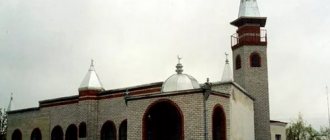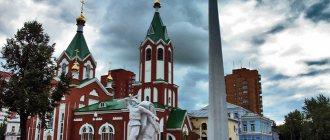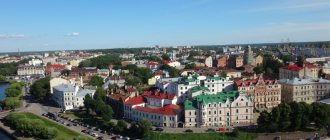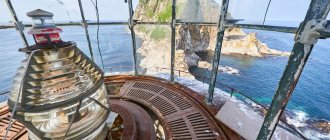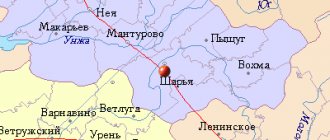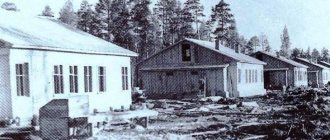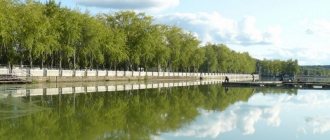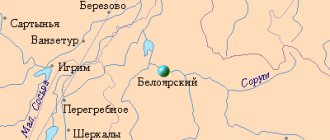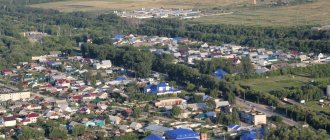General information and history of Glazov
Glazov is the northern capital of Udmurtia. It is located on the left bank of the Cheptsa River, on a hilly plain 1106 km from Moscow. The highest point is Mount Soldir (176.2 m above level), which offers a beautiful view of the entire city.
Panoramic view of the city
More than 95,000 people live in Glazov, mostly people over 30-40 years old, all young people leave for institutes and most of them do not return.
According to one version, Empress Catherine II gave this name to the city after seeing a drawing of the development of the district village. It was she who granted Glazov the status of a city in 1780, despite the fact that the population at that time did not exceed 500 people. But the first mention of the Glazovo settlement in written sources was recorded 120 years earlier.
The general development plan, created by the architect F.M. Roslyakov, was approved in 1804. The main concept of the development was a fan-arc type of layout, according to which all the main streets converged into one square (Freedom Square), which is decorated with the Transfiguration Cathedral, restored after the Bolsheviks.
Map of Glazov with streets and houses
Looking at the map of Glazov with its streets, it is easy to see that they are crowned by the Transfiguration Cathedral. The marking of the city territory was proposed and implemented by the architect F. M. Roslyakov (leading architect of the Vyatka province). It has survived to this day. It has a radial-arc layout. The main streets are:
- Kirova street. Length 1.7 km. There are a large number of banks, cafes and a large children's entertainment center. From Kirov Street you can get to the Creative Workshop and the Museum of Local Lore.
- Lenin Street. Length 1.5 km. Lenin Street on the map of Glazov runs through residential complexes of the city towards the center. From the street Lenin you can get to the P.F. Tchaikovsky Memorial, the Progress sports complex, etc.
- Korolenko Street. There is a monument to V. G. Korolenko, many pharmacies and a restaurant with delicious children's cuisine. Length 1.1 km.
- Sulimova Street. One end abuts the street. Vokzalnaya, others - to the Glazov Furniture Factory. From this street you can get to the Lenin monument. Length 1.3 km.
Walking along these streets you can appreciate the beautiful architecture of the city of Glazov.
Climate and ecology of Glazov
Glazov is located in the temperate continental zone. Winters here are not that cold. In total, there is frost for 2-3 weeks during the winter. Basically, the temperature does not exceed 20-24C, but in summer the weather is very changeable. One day the temperature can reach +35C, and the next it drops to 19-20C. There is also a strong imbalance in temperature at different times of the day.
Glazov is known throughout Udmurtia as the “greenest” city. There really are a lot of trees here, which makes it look great at any time of the year. Mostly poplars, birch and apple trees grow here.
View of the new area
Until recently, Glazov was considered the most polluted city in Udmurtia; many residents are sure that Glazov is radioactive. The “Chepetsk Mechanical Plant” with its uranium production and constant waste emissions into the Cheptsa River, the main drinking source of the townspeople, was to blame for all the rumors and speculation.
ChMZ tailings dump. Photo: https://glazov-retro.info/
Competent services monthly assure Glasovka residents that the environmental situation in the city is good and the indicators do not exceed acceptable standards. And this despite the fact that the city is often watered by yellow rains, and that the number of surgical removals of tumors here is the largest in the republic. The area close to the city is littered with heaps of garbage the size of a football field. Although Glazov itself is quite clean.
Of course, work is underway to improve the environment, for example, in 2005, Glazovsky CHPP-1 was switched from coal to gas, and its emissions have already been reduced by 30 times. Large amounts of money are being invested in water supply sources for further reconstruction. Perhaps then there will be water here that you can drink from the tap.
It should be noted that all this is sponsored by CMP money; the plant’s annual sponsorship reaches tens and even hundreds of millions of rubles.
Glazov on the map of Russia: geography, nature and climate
The city was located in the Urals along the left bank of the Vyatka tributary (Cheptsy River), occupying the northwestern part of Udmurtia. The geographical position of the city is not entirely favorable. If you look at a map of Glazov from a satellite, it is easy to see that its territory is cut into component valleys of the large rivers Malaya Syya, Cheptsy, Syya. The terrain is predominantly hilly. There are a large number of large ravines.
A temperate continental climate prevails here - summers are always hot and rather dry, and winters are cool. The average annual precipitation is only 550 mm. But the most unpleasant thing here is the incessant winds. In summer there are dry winds accompanied by thunderstorms. Its gusts can reach 15 m/s. The calm here is a luxury. Temperature in January (average) -150C, in July +23-+450C. An unpleasant climatic phenomenon is a severe imbalance of temperatures during the day.
Population of Glazov
In 2007, Glazov lost its status as a city with a population of one hundred thousand. Since then, the population has been decreasing every year. At the beginning of 2014, it was 95 thousand people, which is 200 people less than in 2013. The number of children born is also decreasing, and mortality is increasing.
The bulk of the population consists of able-bodied citizens over the age of 25 and pensioners. Schoolchildren and kindergarteners make up about 18%, but there are problems with young people from 17-24 in Glazov. Due to the small number of universities, the vast majority of graduates travel to different cities of Russia, mainly to Moscow and St. Petersburg.
City Day 2011
There are only 2 universities in the city, one of which is GGPI (Pedagogical), and the second is a branch of Izhevsk State Technical University. Of course, in Glazov there is a medical school, college, technical schools, etc. But, in general, the level of education is not very high.
Kind and sympathetic people live here, although you cannot tell this when meeting the locals, they seem gloomy and unfriendly, but this is not so. If you ask a city resident the way to this or that place, he will definitely tell you everything in detail and even guide you.
Glazovians respect the history of the city and Russia, so there are no skinhead groups here, and not many representatives of other subcultures. Cases of vandalism are also rare. But, just as in every barrel of honey there is a fly in the ointment, so there are immoral individuals among the townspeople.
Map of the city of Glazov with roads. Transport infrastructure
Getting around the city is provided by public transport , namely buses. Today Glazov is served by about 15 routes. But before 2011 there were significantly more of them. About 9 routes were closed due to unprofitability. The map of the city of Glazov shows that the large highway P 321 “Izhevsk-Igla-Glazov” runs through the entire city. It connects two large populated areas. The city also operates:
- Glazovsky railway station - the station of the same name is located on the Perm-Kirov section (northern branch of the Gorky railway). The distance by rail from Glazov to Moscow is 1170 km (via Yaroslavl) and 1106 (via Nizhny Novgorod). From the city of Glazov to the capital of Udmurtia, the city of Izhevsk, it is only 197 km by rail.
- Several large local roads connecting the settlement with the regions: Yukamenskoye, Yar, Krasnogorskoye, Balezino;
- Local bus station - located on the street. Sulimova, 73.
The closest airport to Glazov is in Izhevsk (183 km). There were rumors about the construction of the Northern Highway express route through the city, but in 2013 the project was changed. There is no information about the construction of a new road yet.
The nearest port is in the city of Sarapul on the Kama River.
Districts and real estate
The city's social infrastructure is quite well developed. Almost every district is equipped with kindergartens and playgrounds, schools and shops, entertainment centers and companies providing various services.
Glazov Map
Glazov is divided into 5 districts, radically different from each other in appearance.
Old district
The historical part of the city, with the first brick buildings designed by famous St. Petersburg architects. Basically, these are two-story houses with 12 apartments, built in the 50s of the 20th century. The area itself is very quiet and peaceful.
Old area. Overview view
On its territory there is the only park of culture and recreation, the Progress Ice Sports Palace, by the way, the very first in the republic. There is also an athletics stadium and a swimming pool "ChMZ". On the territory of the district there is a hospital town, most schools and kindergartens, and many specialized playgrounds for children of different ages.
Park of Culture and Leisure named after. Gorky. Photo https://glazov-retro.info/
The downside of the old area is the small number of shops, mostly small stalls with the most necessary products. There are also supermarkets, but there are only 3 of them in the entire area. The average cost of real estate in this area is the second in the city and is about 1,350,000 rubles for a standard one-room apartment in a house from the Khrushchev era. Many of the townspeople consider the old district to be the most prestigious.
Main st. Kirov
Old area. Komsomolskaya st.
Western region
Private houses and cottages predominate here; there are also several multi-storey apartment buildings.
A distinctive feature of this area are the names of the streets (Pushkin, Chekhov, Nekrasov, Krylov, etc.). There are no kindergartens and only 1 school, there are practically no significant objects except. In the western region there are 3 garage cooperatives and only four operating stores with the most necessary products.
West. Garage cooperative
But the area is the quietest and least criminal. The cost of a one-room apartment does not exceed 1,200,000 rubles.
Center
Of course, all shopping centers and large stores, fitness centers and bars, a large number of pharmacies and cultural and leisure establishments are collected here.
central square
There are few residential buildings in the center; as a rule, they are all multi-storey with a large number of apartments, with an average cost of 1,350,000 rubles for a one-room apartment.
Center. St. Kirov
There are also railway and bus stations, a children's clinic and a regional hospital.
Railway station
The infrastructure of this area is the most developed compared to others.
New area
New area
The largest number of apartment buildings, kindergartens and schools. Basically, the houses are built in an L shape and are located opposite each other in a square shape. Each courtyard has a shop and a children's playground.
Panoramic view of the New District
On the territory of the new area there is an Izhtrading hypermarket and several supermarkets, many cafes and clubs. A fairly developed area with the highest cost of housing. You can buy a one-room apartment for 1,400-1,500,000 rubles.
The intersection of K. Marx and Tolstoy streets
Aerodrome
Krasnogorsk tract
The private sector is fundamentally dominant. It is separated from the city by a railway. You can get to this area by car across the bridge, or on foot through the overpass. The airfield is the least favorable area with the vast majority of private houses. The highest crime situation in the city, a large number of drug addicts and alcohol dependent residents. Although, there is a hospital, a school and several kindergartens.
Fifth section
This is an industrial microdistrict with wholesale warehouses and a small number of residential buildings. The area is equipped with the only social rehabilitation school in the city and a popular college among young people.
St. Soviet
In addition to the areas within the city, there is a cottage village "Berezovy" 1.5 km away and the village of Shtanigurt 500 meters from Glazov. Birch village is a very beautiful private sector with expensive and impressive cottages and mansions.
P. Berezovy. Overall plan
The cost of an average house along with 6 acres of land is about 5,000,000 rubles. Despite the fact that there is only 1 store and nothing else.
Shtanigurt is located just a kilometer from the village of Berezovoy, but the cost of houses here is much lower, and does not exceed 3,700,000 rubles. This is a full-fledged area, with its own kindergarten, sausage factory, school and even a club. A large number of shops.
Shtanigurt
Glazov (urban district)
Main article: History of Glazov
Background
Glazov was first mentioned in 1678 on the pages of the household census of Mikhail Petrovich Voeikov and clerk Fyodor Prokofiev as part of the Chepetsk share of the Karinsky camp of the Khlynovsky district as “the village of Glazov beyond the Cheptsey River,” consisting of 11 Udmurt and 1 Tatar household [5] [6]. The use of the term “village” rather than “pochinok”, as well as the significant population size, indicates that by the time of the census the settlement had already existed for some time. He is not mentioned in the 1662 census, so he could have appeared in any year between these censuses. Pochinok, judging by census data, was founded by people from the neighboring village of Krasnaya Sludka[7][8].
After the construction of the wooden Ascension Church in 1748, the village became the village of Glazov[9][10]. In the 17th-18th centuries, the population of the village was replenished by Russians who moved to the Urals[6].
District city within the Vyatka province
On September 11, 1780, by decree of Catherine II, the village of Glazovo received the status and coat of arms of the city[9]. The number of inhabitants was less than a thousand people. The newly formed city became the center of the Glazov district as part of the Vyatka province[11][10][12]. On May 28, 1781, the city’s coat of arms was approved[6].
In 1793, a stone cathedral called Preobrazhensky was built on the central square of the city. From 1796 to 1818, the mayor of Glazov was Pyotr Fedorovich Tchaikovsky, the grandfather of the composer P. I. Tchaikovsky[6]. Under Mayor Tchaikovsky, Glazov acquired a town hall and the first hospital. From 1797 to 1920, Glazov was the center of the Glazov district of the Vyatka province[10].
Since 1804, the development of the city was carried out according to the plan of the St. Petersburg architect Ivan Lem, approved in 1784. A rare type of radial-arc layout of the city center has survived to this day. The shape of the central square in plan represents an eye, from which seven eyelash streets radiate, which gives the name of the city a special symbolism. The detailed layout of streets and squares was completed in 1804 by F. M. Roslyakov[13][12].
In 1811, the acting head of the city was the merchant of the 2nd guild Ivan Seliverstovich Volkov[14].
On October 7, 1823, Emperor Alexander I visited the city. He stayed at the Lyapunovs’ house and presented the hostess with an expensive ring[15].
In 1826, participants in the Decembrist uprising were transported to Siberia through Glazov. In 1837, while traveling to the Urals, the future Emperor Alexander II stopped in Glazov. He was accompanied on this trip by the Russian poet Vasily Andreevich Zhukovsky. In honor of this event, the Alexander Nevsky Chapel was built in the city (it has now been restored according to the original sketches).
By 1856, Glazov had become the main trading center of the county. Bread, flax, leather, hemp, and lard were exported abroad through the port of Arkhangelsk. In the second half of the 19th century, along with many other cities of the Russian Empire remote from the capitals, Glazov was a place of exile for participants in various political and social movements. In 1879, V. G. Korolenko [9] [12] was exiled here, who later described Glazov in the essay “The Unreal City” (1880). In 1867, there were 44 exiles in Glazov, in 1870 - 78, in 1873 - 93 people[6].
In 1868, in Glazov, O. L. Knipper-Chekhova was born into the family of a process engineer[6].
In 1876, a women's gymnasium was opened in the city, which at the beginning of the 20th century became a full-fledged secondary educational institution. Soon a men's gymnasium appeared in the city. In 1877, construction of the Transfiguration Cathedral began on Cathedral Square. On September 24, 1879, the unfinished cathedral collapsed[16]. An emergency commission from Vyatka revealed errors in the builders’ calculations. After 8 years, according to the corrected drawings, everything was restored with special care, taking into account the strength and beauty of the brickwork. On June 15, 1887, the revived temple was consecrated. Since 1889, the Glazov Vicariate of the Vyatka Diocese was located in the city.
Since 1890, handicraft enterprises began to appear in Glazov. Brick, sawmill, shoe production, and soap factories began to operate. The production of gingerbread and cakes has undergone significant development. A glass factory was built in 1901[6].
In 1898, the Trans-Siberian Railway passed through the territory of Glazovsky district. Until 1917, the small provincial town was dominated by one- and two-story log buildings and a few brick ones[12].
| The city of Glazov at the turn of the 19th and 20th centuries |
Revolution and Civil War
During the First World War, marching companies and battalions for the active army were formed in Glazov; There were two hospitals for the wounded. The city was filled with revolutionary-minded soldiers. On March 4, 1917, the Council of Workers' and Soldiers' Deputies was elected in Glazov under the chairmanship of A.I. Shultz[17]. The Bolshevik Council of Workers', Soldiers' and Peasants' Deputies actually became the political power in the city and district even before the armed uprising in Petrograd[18]. Having received a message about the overthrow of the Provisional Government, the executive committee of the Council officially declared its autocracy.
On January 20-24, 1918, the Glazov District Congress of Workers', Peasants' and Soldiers' Deputies announced the transfer of power to the Soviets[17]. I. Ya. Shubin was elected Chairman of the District Council. In the summer of 1918, large anti-Bolshevik uprisings swept through Svyatogorsk, Bykovskaya, Afanasyevskaya and some other volosts of the Glazov district. They were brutally suppressed by Red Army units stationed in Glazov[19].
In May-June 1919, the Eastern Front of the Civil War passed through the city. Due to the difficult situation for the Red Army, Stalin and Dzerzhinsky came to Glazov. On June 3, 1919, the city was occupied by Kolchak’s Siberian Army[20] (General Pepelyaev’s group), but on June 15 it was again taken under control by the 3rd Red Army[20]. In both cases there was no fighting in the city.
Soviet years
Extract from the minutes of the meeting of the Presidium of the All-Russian Central Executive Committee on the transfer of the regional center from Glazov to Izhevsk.
June 10, 1921. Due to Glazov's proximity to Vyatka and the Udmurt population that existed in the city, it became the administrative center of the formed Votsk Autonomous Region on November 4, 1920. In February 1921, the Udmurt Regional Revolutionary Committee was created in Glazov, headed by I. A. Nagovitsyn. At the end of June - beginning of July 1921, the regional administration was transferred to Izhevsk[6][21]. By 1923, the city's population reached 4,397 inhabitants.
In the mid-1930s, the first master plan for Soviet Glazov was developed[22]. The project architect, Emmanuel Mekler, preserved the “beams” of I. Lem, while simultaneously planning the development of the main building to the west. At the end of the 1930s, construction of a flax mill began.
By June 1941, 16,906 people lived in Glazov. At the beginning of the Great Patriotic War, enterprises and institutions from the western regions of the country were evacuated to the city. These were mainly defense factories with equipment and people. The tobacco factory and the 2nd Leningrad Infantry School, evacuated from Leningrad, worked for the needs of the front, as well as cartridge plant No. 544, built on the territory of a flax mill and equipped with equipment from cartridge factories evacuated from Podolsk and Kuntsev.
In the post-war years, the construction of a backup plant No. 12 began in the city. On the basis of the cartridge plant No. 544, the Prikamsk office of the Glavgorstroy PGU was created - a uranium production enterprise (the future Chepetsky Mechanical Plant). Construction of a factory workers' village began to the west of Glazov. In the first years of construction, the village was built up with wooden and infill two-story houses, as well as Finnish houses. In 1947, the first brick residential apartment buildings were built in the area of Parkovaya and Shkolnaya streets. Since 1948, the workers' village began to be built up according to a new general plan with standard two- and three-story brick houses. In addition to residential buildings, in the first years of construction of the new factory village, kindergartens, a hospital town, a school, a canteen, a cinema, a House of Culture, etc. were built. For the construction of a new production facility, ChMZ and the village, all available construction forces were involved, including including repressed Russian Germans. New energy services were designed and urgently put into operation, and the city was electrified and heated.
By the Decree of the Presidium of the Supreme Soviet of the UASSR dated October 21, 1949 and the Decree of the Presidium of the Supreme Soviet of the RSFSR dated January 2, 1950, Glazov was classified as a city of republican subordination[21].
Since the late 1950s, the construction of so-called “Khrushchyovka” buildings began in the city. The factory's workers' settlement began to be actively built in an eastern direction, towards the old, pre-war buildings of Glazov.
During 1960-1962, the Transfiguration Cathedral on Freedom Square was destroyed, despite the fact that in 1945 the cathedral was recognized as an architectural monument of the Ukrainian Autonomous Soviet Socialist Republic. The formal basis for the demolition of the temple was the approved design of a new reinforced concrete bridge across the Cheptsa River, the approach route to which is located on the site of the demolished cathedral[16]. In 1962, the last church in the city, St. George's Church, was demolished.
In 1965, the first nine-story buildings in Udmurtia were commissioned on Lenin Street.
At the end of the 1960s, a new master plan for the city was developed. In the coming decades, the development of the city was planned in the south-west and north-east directions, on the site of the old wooden buildings. The first phase of construction involved the development of a large residential area south of the railway. Twenty thousand people were to settle in the southwestern residential area, and a pond was planned on the Syga River. The northeastern residential area was planned to be built in the second place due to the high cost of construction, the need for soil reclamation and the demolition of old wooden buildings. In 1970, due to the discovery of sand quarries near the city, it was decided to move the construction of the northeastern residential area to the first stage of construction. In the 1970s, microdistricts V, I, K and L were built.
In the early 1980s, construction began on a large residential area of Levoberezhye-1 to the northeast of the historical part of the city. Residential and public buildings were designed specifically for the area at various Moscow design institutes. In the late 1980s, construction began on a large instrument-making plant belonging to the All-Russian Scientific Research Institute of Technical Physics and Automation.
In 1987, celebrations were held in Glazov to mark the birth of its 100,000th resident[23].
Beginning in the 1990s, it was planned to begin building three large residential areas at once in Glazov. The Left Bank-2 area was planned in the northeastern direction. In the southern direction it was planned to build up almost the entire territory of private development. In a western direction, the Khimmash plant developed a project for a residential area on the site of the village of Vaebyzh.
Modernity
Before reforms were carried out in the 1990s, the quality of life of the population in Glazov was significantly higher than the national level[24]. In the current political and economic situation at that time, highly urbanized Glazov, closely associated with the military-industrial complex, found itself in a difficult situation. The decline in production, caused by a drop in demand for products, caused an outflow of qualified personnel. Since the beginning of the 1990s, as a result of the economic crisis, the volume of industrial products produced by city enterprises has sharply decreased[25]. Some enterprises, unable to withstand market competition, ceased or suspended their activities. The instrument-making plant was never completed. There was practically no housing construction.
Since 2000, the economic situation has been improving, some enterprises have been increasing production volumes, and the construction of residential buildings has resumed.
In 2007, the city lost its status as a city with a population of one hundred thousand[23].
In the first decade of the 21st century, large-scale work was carried out to improve Freedom Square and reconstruct the historical ensemble of buildings. A new Transfiguration Cathedral was built on the site of the Ascension Church.
Infrastructure condition
The housing and communal complex of Glazov is quite well developed. The main reason for this is the large number of housing and communal services companies and housing offices, which are in constant competition for customers. Therefore, city residents always have a choice.
But, despite this, the amounts in receipts tend to increase with frequent variability, and the range of paid services is not performed properly: the staircases of houses are rarely washed, most entrances do not have benches and trash cans, the surrounding area is cleaned well, but rarely.
Very often there are interruptions in the power supply and water supply, sometimes it is turned off without warning. The condition of the water itself leaves much to be desired, and this despite the fact that the Glazov Municipal Unitary Enterprise “Vodokanal” was awarded the title of the best enterprise in Russia in this field. But things are going well with the heating; it is turned on at the scheduled time and in sufficient volume to maintain a good temperature in the apartment.
Road wars
The road situation in the city is quite tense. Even the central street of Glazov looks like a sieve of potholes and hummocks, let alone the secondary streets and especially the courtyards. Of course, potholes are often patched up hastily, but the effect lasts no more than 3-4 months.
Road surface on the street. Dzerzhinsky
Despite the small population, there are a lot of cars here, so traffic jams during rush hour have become commonplace, but during the day and late evening it is not difficult to get from one end of the city to the other.
The bus is the only type of public urban transport with a large number of routes covering all corners of the city and surrounding areas.
Enterprises and work in Glazov
Glazov is a well-developed industrial center and ranks second in terms of production volumes in Udmurtia. The most important sector of the city's economy is industrial production. It determines budget income and employment. Of course, the dominant position here is occupied by the city-forming enterprise - OJSC Chepetsky Mechanical Plant, which is part of the fuel industry and is the center of interests of the state corporation Rosatom.
Administrative building of ChMP
ChMZ is the largest enterprise in the Urals and occupies a leading global position in the production and processing of uranium, zirconium, calcium, etc. It is involved in the production of nuclear fuel and superconducting materials for the world's first fusion reactor. The plant employs 15% of the population, 4% of which are young people under the age of 28. In general, the plant is not afraid to hire young specialists; on the contrary, this is one of its priorities. Work at ChMP is considered the most prestigious and promising in the entire city, which is justified by the high salary and numerous benefits and allowances. But it’s quite difficult to get a job there, and there are practically no vacancies.
Other enterprises and factories in the city produce cabinet and upholstered furniture, sewing and ceramic goods, animal feed, food, fertilizers, etc.
Among the dominant ones is O, which produces all types of sausages, meat, eggs, offal and canned food. You can also highlight OJSC UZSM, which produces solid bricks; SEZ “Teploagregat”, which produces heating and ventilation equipment, etc.
Don’t forget about Liquorvodochny, whose products have made the city famous not only in Russia, but also abroad.
The positive dynamics of enterprise growth has a positive effect on the employment of city residents. We can say that there is a lot of work in the city, but the main enterprises make considerable demands on potential employees, which makes employment difficult. It is much easier to get a job as an accountant, salesperson or teacher.
The number of taxi services has increased greatly in recent years. About 3% of townspeople are, in one way or another, involved in this area of activity.
According to official statistics, the average monthly salary in Glazov does not exceed 19 thousand rubles. Of course, at an average price level, this is a good indicator, but it should be taken into account that an ordinary salesperson in a store earns about 8-9 thousand, and a simple worker at the same Chernobyl Metallurgical Plant receives 25-30 thousand rubles.
The trade sector is represented mainly by small shopping centers and supermarkets with federal and regional chains (Magnit, Izhtrading). Recently, there has been pressure from large chains on local entrepreneurs, who often cannot withstand such competition. Notable for the city was the opening of the Passage shopping center, with a retail area of 2160.00 sq.m. Brands such as CentroObuv, Incity, Sabra, Concept, etc. are represented here.
Shopping center Passage
And in the central district of the city, the “Central Market” is open from Tuesday to Sunday. They mainly sell Chinese clothes and shoes, bought on Moscow markets.
Central Market. Photo https://glazov-retro.info/
Crime
In general, the criminal situation in Glazov is not bad, there is no trend towards an increase in crime. Compared to 2011, crime detection increased by 12% and is 74%. For comparison, similar figures for the republic are 2% and 65%, respectively. The number of serious and especially serious crimes has decreased by 25%, almost all of them have been solved. But corruption-related crimes in the city are growing from year to year, as are crimes related to the sale and storage of drugs. In general, it should be noted that there are problems with this in Glazov. Almost all types of drugs are sold here, from smoking weed to heroin, and accordingly, the number of drug addicts is also growing.
Fights in the city are a common occurrence, sometimes ending with the use of piercing and cutting objects.
Of the particularly high-profile and sensational crimes, one can note the periodic appearance of maniacal rapists and pedophiles. From 2004 to 2009, a rapist operated in the city, whose victims were 16 girls aged 19 to 27 years. In 2009 he was caught.
In 2012, a young pedophile abused 3 children, aged from 2 to 7 years. The best police officers of the city and Moscow colleagues were involved in his search. Thanks to the vigilance of citizens who promptly reported a similar person, the maniac was detained. The examination found him mentally ill.
A relatively small number of crimes and a high detection rate lead to a significant improvement in the safety of citizens.
Sights of Glazov
The Idnakar settlement and the museum of the same name, with excavation exhibits, are perhaps the most important attraction of Glazov. The settlement is located 4 kilometers across the river, and dates back to the 9th century. Here you can get acquainted with household items of that time and their history. Experienced guides will captivate any skeptic with their most interesting stories. And for visually impaired tourists there are special layouts with descriptions in Braille.
The building of the former women's gymnasium has historical value; today it houses the Glazov Museum of Local Lore, with 8 halls of various exhibitions. Some may say that a museum is boring, but this definition does not apply to this place. Thanks to the modern and creative approach of the workers, visiting the museum becomes an exciting journey through different eras.
The main square of the city is pl. Freedom, is the center of all celebrations.
Transfiguration Cathedral. Pl. Freedom
Along with modern buildings, merchant houses of the 18th century coexist perfectly here, which have still preserved their original appearance.
Just below the square is the Alexander Nevsky Chapel, built in 1837 in honor of the arrival of the future emperor, Alexander II, in Glazov. The chapel was destroyed by the Bolsheviks and was recently rebuilt according to ancient sketches.
A favorite place for newlyweds is the Eden flower shop; there used to be an underground Bolshevik printing house here. This is not just a store, but truly a heavenly place, on the left side of the center of the square. Freedom.
Flower shop Eden
The majestic architectural ensemble of the Rossiya OCC makes an equally enchanting impression. This is a wonderful example of the Stalinist Empire style, not inferior to the best buildings of VDNKh. Concerts, exhibitions and city-wide competitions take place here.
The most striking cultural center is the Glazov Drama Theater "Parafraz", founded in 1983. Performances are staged here for different age groups. The theater is often invited to national and international festivals.
In numerous squares and parks there are monuments to Lenin, Marx, Pavlik Morozov, and wooden totem sculptures.
Monument to a bottle of vodka. Previously it was located opposite the distillery. Today - dismantled

